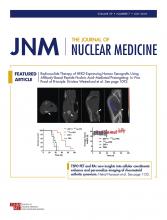TO THE EDITOR: We would like to comment on the letters by Boellaard et al. in this issue of The Journal of Nuclear Medicine and Barrington et al. (1). The authors urge reporters not to use PET reconstruction algorithms, which exploit point-spread function (PSF) modeling or Bayesian penalized likelihood (BPL) techniques for response assessment in lymphoma. This call to ignore a more sensitive reconstruction technique, demonstrated to yield image data closer to phantom truth (2), and with the ability to detect smaller volume disease, is of concern. The Deauville criteria (DC) were designed to simplify and standardize how we interpret an 18F-FDG PET/CT scan for the presence or absence of active lymphoma and to guide clinicians in the management and prognosis of their patients. The comment that there is “a shift toward more positive reads” is unfortunate as it references a letter by Barrington et al. that has only anecdotal evidence from 3 patients and is not a peer-reviewed paper or a large-cohort series. We believe there is insufficient evidence to support the recommendation to not use these more sensitive PET/CT reconstruction methods.
Recent publications have emphasized that BPL PET reconstruction is particularly advantageous in patients with high body mass index (3), that is, in patients with the greatest background noise in whom the detection of small abnormalities is most problematic. This improvement in signal-to-noise ratio may improve inter- and intraobserver variation in assessing DC. With older reconstruction techniques, even among experts, interobserver agreement using the DC is only moderate (4), and it has been suggested that this may be because of difficulty comparing the signal in a lesion with noisy background signal in the liver or mediastinal blood (5). PSF and BPL still underestimate true activity in small foci, however, they are a step forward and nearer to phantom truth. This truth can make reporting more challenging, requiring careful consideration of the clinical significance of the detection of small-volume and subtle abnormalities.
The recent publication by Enilorac et al. (6) compared a PSF reconstruction with European Association of Nuclear Medicine (EANM) Research Ltd. (EARL)–compliant reconstruction in 126 diffuse large B-cell lymphoma patients. They concluded that neither DC score nor risk stratification of diffuse large B-cell lymphoma patients was significantly affected by the choice of PET reconstruction and that specifically the use of PSF is not an issue in routine clinical processes or in multicenter trials. In practice, there are probably few patients with discordant DC on ordered-subset expectation maximization versus more advanced reconstructions, with potential to alter management. It will be of immense value to study these patients, which may require collaboration between centers, so that going forward lessons can be learned. Nonetheless, it is also important to remember that the interpretation of interim scans and the decisions related to them are not binary. They should ideally be made in the clinical context, in relation to lymphoma type, stage, and risk factors, such as bulk or B symptoms and the intensity of treatment given before and after the PET scan (5).
Alongside the use of interim PET, it is important to remember that PET is used to more accurately stage lymphoma at presentation, with significant value in detecting extranodal disease, and this is likely to be further improved using more sensitive imaging techniques. The use of new reconstruction methods at baseline staging then effectively mandates its use for follow-up scans, as the detection of new or progressive disease remains important.
We would argue that early disease detection often leads to better treatment and clinical outcomes. We need to embrace technologic advances and innovation even if these lie outside our comfort zone. The current situation is very similar to any major advance in imaging, such as the transition from 2-dimensional to 3-dimensional PET reconstruction. However, this learning curve does not mean these advanced methods should be avoided; we would suggest that patients with malignancies should be staged and followed up as accurately as possible using the most sensitive technique available. This may require alteration to the DC as previously occurred with changes to the International Harmonization Project in 2014 after the increased use of more modern PET/CT scanners.
Footnotes
Published online Apr. 26, 2018.
- © 2018 by the Society of Nuclear Medicine and Molecular Imaging.







